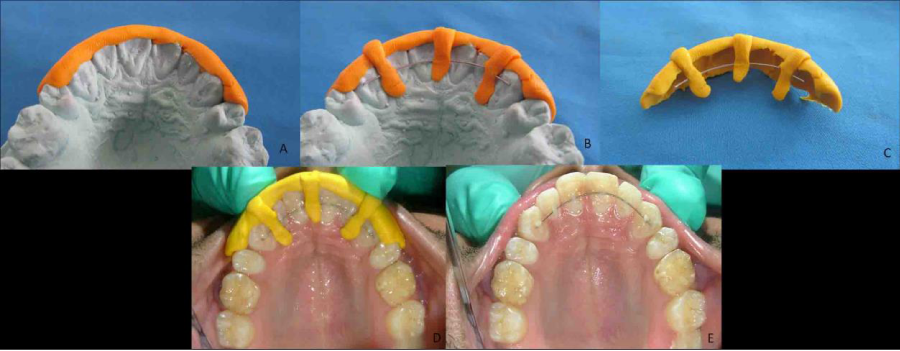Procedure
Fabrication of Lingual Retainer made easy

Madhvi Bhardwaj, Shantanu Khattri and Rohit Kulshrestha*
Department of Orthodontics and Dentofacial Orthopedics, Career P.G Institute of Dental Sciences, Lucknow, Uttar Pradesh, India
*Address for Correspondence: Rohit Kulshrestha, Consulting Orthodontist, Private Practice Mumbai, India, Tel: +919870499761; Email: [email protected]
Dates: Submitted: 07 November 2017; Approved: 17 November 2017; Published: 20 November 2017
How to cite this article: Bhardwaj M, Khattri S, Kulshrestha R. Fabrication of Lingual Retainer made easy. J Clin Adv Dent. 2017; 1: 026-027. DOI: 10.29328/journal.jcad.1001005
Copyright License: © 2017 Bhardwaj M, et al. This is an open access article distributed under the Creative Commons Attribution License, which permits unrestricted use, distribution, and reproduction in any medium, provided the original work is properly cited.
Keywords: Lingual retainer; Indirect bonding; Transfer tray
Abstract
Direct bonding of a lingual retainer is challenging because it requires a long working time on the lingual aspect of the anterior teeth. Due to no direct vision there is a risk of contamination from saliva and moisture, which can cause bond failure; and it is difficult to apply the adhesive exactly where it is needed. The indirect method described in this article shows an easy way to increase better-quality bonding of the retainer.
Introduction
Conventional removable retainers are intended to guide the post-treatment settling process of the dentition [1]. These retainers are frequently not efficient enough to prevent relapses of rotation and alignment of the maxillary anterior teeth due to many reasons [2]. Certain types of malocclusions like crowding, spacing, rotations require more secure permanent retention than can provided by removable retainers. There are various direct and indirect technique for placing lingual retainers [3-6]. This new technique of bonding lingual retainers is easy, simple and can be done chairside saving appointment time of patients.
Technique
• PVS impression material (Zetaplus Zhermack, Badia Polesine, Italy) is mixed and added on the labial surface of anterior teeth covering the incisal edges for proper guidance while placing the tray in patients mouth (Figure 1).
Figure 1: a) Application of putty on labial and incisal aspect of maxillary anterior teeth cast. b) Placement of vertical arms of putty along with retainer wire. c) Putty template with retainer wire. d) Placement of putty template on the maxillary anterior teeth. e) Bonded lingual retainer.
• A multi-stranded 0.0175-inch stainless steel Wildcat wire (GAC, Bohemia, NY) was used and was adapted on the lingual surface of the anterior teeth on the working cast and vertical arms are made by putty to secure the wire in the adapted area.
• Retainer wire is removed from the cast along with the putty and inserted in the 22patient’s mouth, and cured by using flowable composite.
Conclusion
The technique can be used for both the arches. Rubber dam can also be used for absolute isolation and to increase bond strength. No difficulty is seen in removing the retainer wire from the putty material post bonding. This step by step procedure for fabricating lingual retainer is less time consuming and can be fabricated chairside reducing patient appointments and laboratory procedures. Vacuum-formed thermoplastic materials can also be used to form the indirect tray, but the above method yields a much more precise fit in the mouth. Furthermore, the elastic properties of the silicone make it safer during tray removal after bonding. The silicone tray takes less time to construct and is also neater than thermoplastic trays.
References
- Sari Z, Uysal T, Basciftci FB, Inan O. Occlusal Contact Changes with Removable and Bonded Retainers in a1-Year Retention Period. Angle Orthod. 2009; 79: 867-872. Ref.: https://goo.gl/TrT1Br
- Atack N, Harradine N, Sandy JR, Ireland AJ. Which Way Forward? Fixed or Removable Lower Retainers. Angle Orthod. 2007; 77: 954-959. Ref.: https://goo.gl/cGjDXg
- Haydar B, Haydar S. An indirect method for bonding lingual retainers. J Clin Orthod. 2001; 35: 608-610. Ref.: https://goo.gl/GRSJbL
- Cook BJ. Technique clinic a direct bonding technique for lingual retainers. J Clin Orthod. 2002; 36: 469. Ref.: https://goo.gl/TjJ7xT
- Lim SM, Hong RK, Park JY. A new indirect bonding technique for lingual retainers. J Clin Orthod. 2004; 38: 652-655. Ref.: https://goo.gl/GCPT36
- Costa MT, Lenza MA, Amorim-Brito RS. Bonding a v-loop lingual retainer with a DuraLay transfer tray. J Clin Orthod. 2005; 39: 44-46. Ref.: https://goo.gl/HkkMRf
